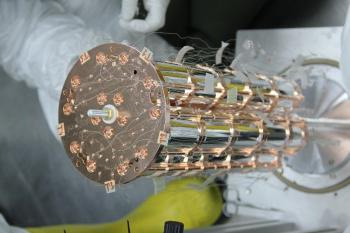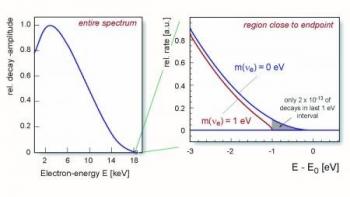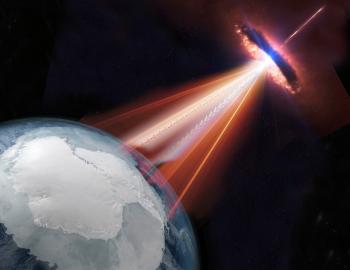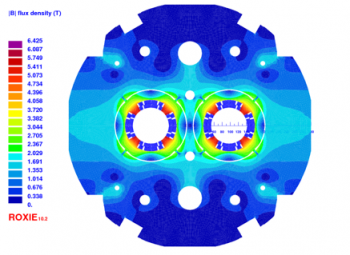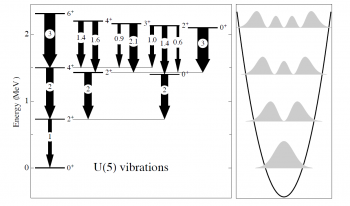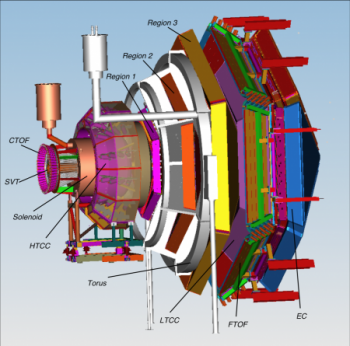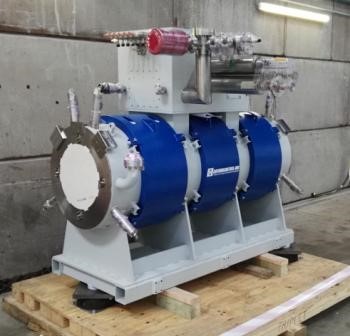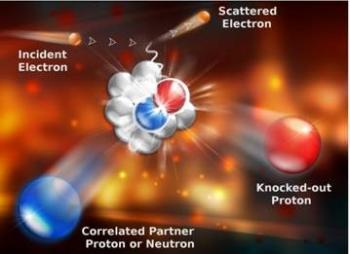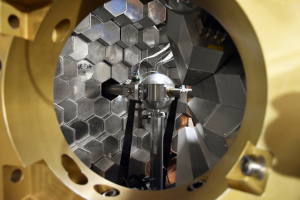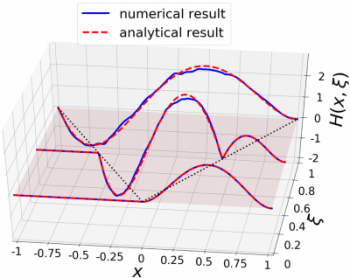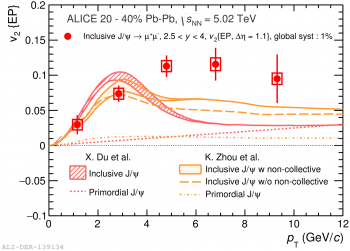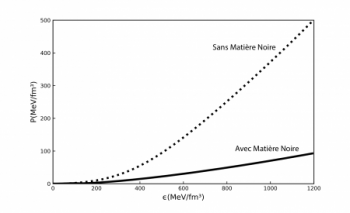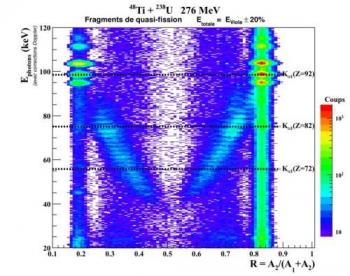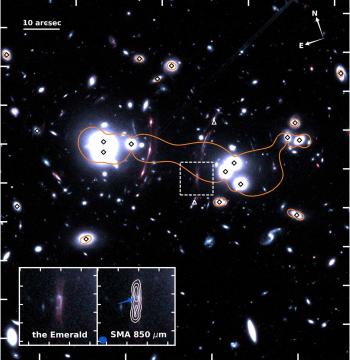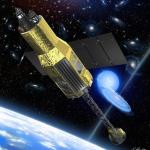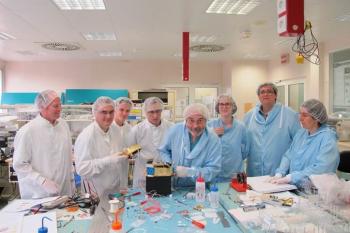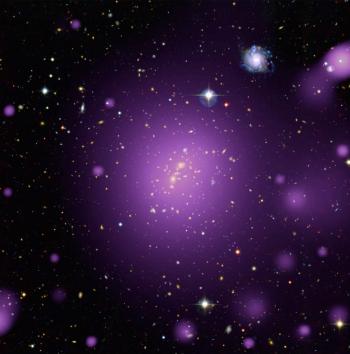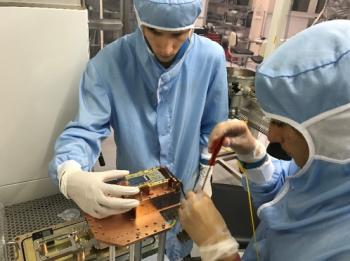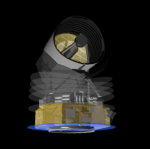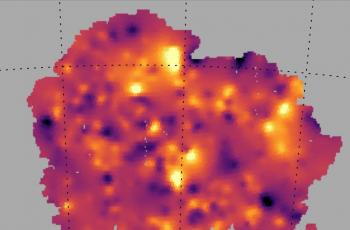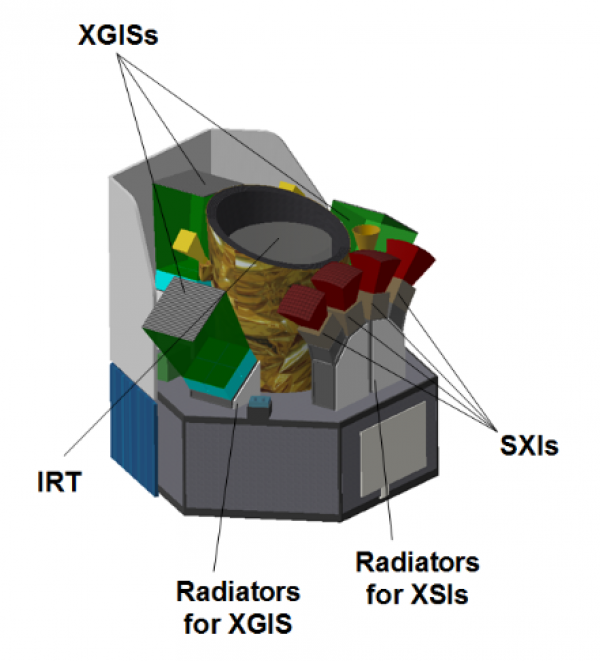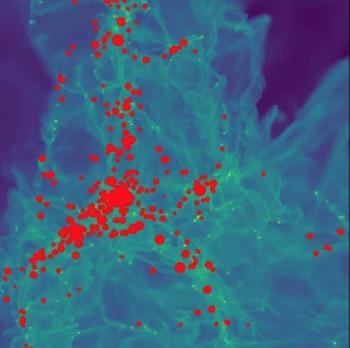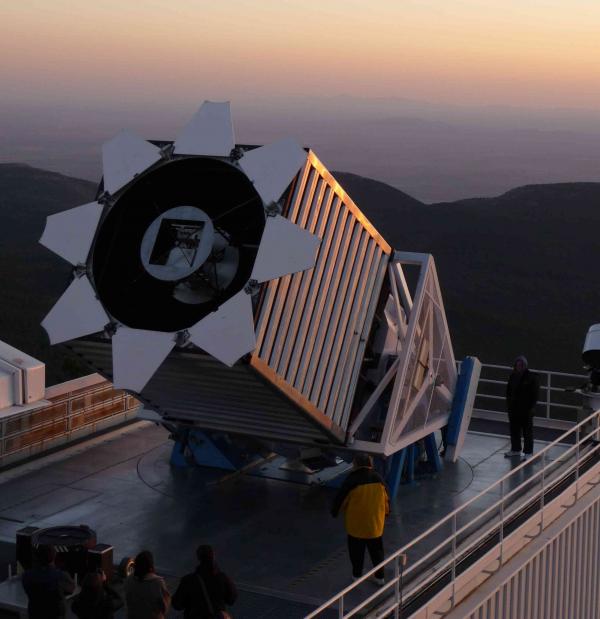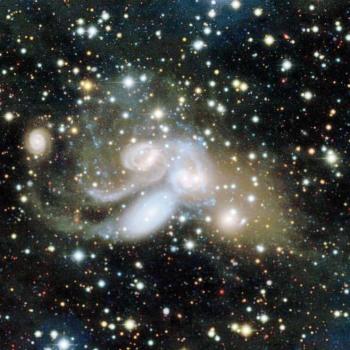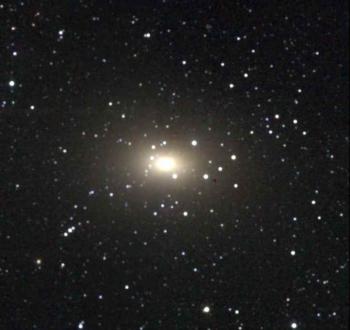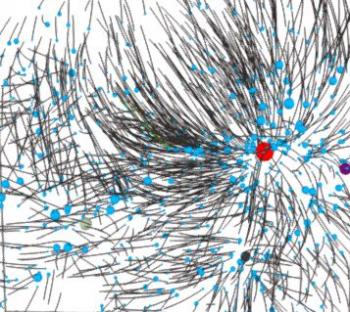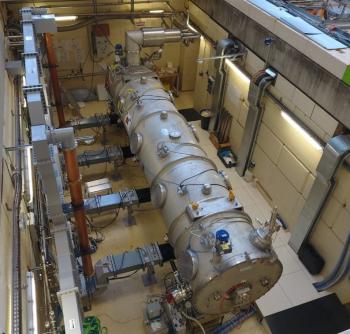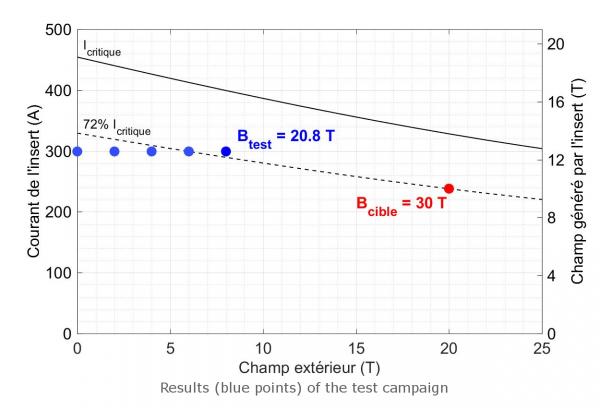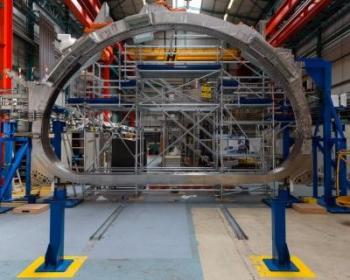In 2018, IRFU is participating in a publication CUPID-0: the first array of enriched scintillating bolometers for 0νββ decay investigations which reviews a first matrix of bolometers installed in the Gran Sasso laboratory in Italy, with the objective of tracking the double beta decay without neutrino emission (0νββ) that will reveal the nature of neutrinos. This publication describes the integration of the detectors, their testing and commissioning for a first data collection that began in 2017 with the participation of IRFU and IN2P3 researchers at various stages. The test results show a very good response of the electronics and cryogenic systems. The mean value in energy resolution proves the unmatched efficiency of this technique for measuring radioactivity, which makes it possible to dissociate beta decay from alpha decay, a source of background in this research.
What is the mass of neutrinos? To answer this fundamental question, the KATRIN experiment was designed and built by an international collaboration at the Karlsruhe Institute of Technology. On June 11, 2018, an international symposium marked the beginning of data acquisition. The first electron spectra from tritium decay have been analyzed with an analysis chain developed at IRFU. Everything conforms to the required specifications and the first long data taking campaign for physics can start. First results expected in 2020.
A hundred years old mystery might get resolved with the detection of neutrinos by the IceCube collaboration coming from a known active black hole. Irfu, which coordinate those observations with the H.E.S.S. telescope, did not detect anything for now but the multi-messenger astronomy has just begun…
The ATLAS and CMS collaborations, involving teams from CEA/IRFU and CNRS/IN2P3, announced on 4 June 2018 at the LHCP conference the direct observation of the coupling of the quark top to the Higgs boson. Studying the interaction between the Higgs boson and the heaviest elementary particle known, the quark top, is a way of investigating the effects of new physics, which must take over from the standard model.
The results of the analyses, orchestrated by IRFU/DPHP physicists, led to the observation of this rare process and are in agreement with the predictions of the standard model. In the coming years, both experiments will collect much more data and improve the accuracy of their measurements, which could reveal a deviation from the prediction of the standard model.
CMS article: https://journals.aps.org/prl/abstract/10.1103/PhysRevLett.120.231801
arXiv link for the ATLAS article submitted to publication : https://arxiv.org/abs/1806.00425
A new project is opening today, Friday, June 15, 2018, at the LHC, the large Hadron Collider. Initiated in 2011, this project aims to bring into service by 2026 a high-luminosity LHC (HL-LHC) that will increase the number of proton-proton collisions and collect more data. France contributes significantly to this project (up to € 180 million, including payroll). CNRS and CEA teams are particularly involved in research and technological developments on superconducting magnets as well as in the detectors and accelerator update. On the French side, more than 400 scientists are accompanying the renewal of the world's largest and most powerful particle collider.
CERN Highlights (Posted by Corinne Pralavorio -CERN- on 15 Jun 2018)
The STEREO experiment presented its first physics results at the 53rd Rencontres de Moriond1. STEREO is a neutrino detector made up of six scintillation liquid cells that has been measuring, since November 2016, the electronic antineutrinos produced by the Grenoble high neutron flux reactor 10 metres from the reactor core. The existence of a fourth neutrino state, called sterile neutrino, could explain the deficit in neutrino flux detected at a short distance from nuclear reactors compared to the expected value. Indeed, this anomaly could result from a short-range oscillation that would result in less expected electronic antineutrinos being detected because they would disappear into sterile neutrinos. The first results obtained in 2018 after 66 days of data exclude a significant part of the parameter space. The experiment will continue to take data until the end of 2019. By multiplying the statistics by four and minimizing systematic analysis errors, STEREO will be able to shed light on the existence of this 4th neutrino family.
153rd Rencontres de Moriond Electroweak session
The T2K collaboration, whose goal is to study and measure neutrino oscillations, is publishing new results on the interaction of neutrinos with nuclei. This study, in which the T2K group of the IRFU plays a major role, is crucial in that it allows the dominant uncertainty on the oscillation parameters to be restrained. For the first time, protons emerging from the neutrino-nucleus interaction have been characterized using new variables capable of exposing and characterizing nuclear effects.
Theoretical work involving researchers from Ganil, the University of Huelva in Spain and the Racah Institute of Physics in Israel, confirms the vibrational nature of cadmium-110, reproducing experimental observations that called this nature into question. Since the 1970s experiments have revealed the existence of non-vibrational states called "intruder" states. The new theoretical results, which are being extended to all even isotopes of cadmium, therefore solve a problem that is several decades old and has been highlighted by the publisher of the journal Physical Review C.
During an experiment carried out at GANIL in Caen (France), an international team, led by researchers from Irfu and the University of Oslo, studied the shape of the Zirconium-98 nucleus. The shape of a nucleus corresponds to the area where its protons and neutrons can be found. Understanding it means mastering the behaviour of each proton/neutron and their arrangement related to the nuclear force. The objective was to determine the shape of the nucleus in different excited states. The results give a complex scenario, for which three different shapes - spherical, slightly deformed and strongly deformed - coexist within the same nucleus depending on whether it is in its ground or excited state. In addition, its neighbouring nucleus, Zirconium-100 with only two more neutrons, behaves in the opposite way. This sudden change in the shape of these two isotopes is a rare phenomenon that strongly constrains nuclear structure models. These results have been published recently in Physical Review Letters [1].
As part of the new CLAS spectrometer project for the 12 GeV electron energy upgrade of the Jefferson Lab (USA) IRFU has been conducting R&D for more than 10 years to design and build a new generation tracker, using thin and flexible MICROMEGAS detectors that are now operating with the new CLAS12 spectrometer. After one year of installation, this tracker is operational and meets the expected characteristics with more than 95% detection efficiency and a spatial resolution of less than 100μm. After a dedicated data collection to measure the detector response, the new CLAS12 spectrometer is now collecting data for the DVCS physics experiment, where IRFU also participates and which objective is to measure the internal structure of the proton in three dimensions.
The exceptional success of the tracker project, that results from a close collaboration between IRFU's engineering and physics departments (DEDIP, DIS and DPHN), has been an example for other projects. Let us quote the LHC experiments for particle hunting, the muonic imaging of the pyramids, as well as a transfer of know-how to industry.
The first triplet of superconducting multipoles of the S3 Super Separator Spectrometer arrived at Ganil on August 29, 2018. S3 is one of the experiment rooms of the Spiral2 facility. The magnet, with a mass of 2.8 tonnes, is 1.8 m long and almost as high. This innovative type of magnet is very compact despite the number of optical functions it can generate (quadrupole, sextupole, octupole and dipole). It is the first of a series of seven to be delivered to the Ganil.
The magnetic field is generated by a niobium-titanium alloy (NbTi) conductor arranged in an epoxy/glass fibre matrix and operate at the temperature of the liquid helium (4.2 kelvins). The power supply leads are composed of two types of high-temperature superconductors and nitrogen-cooled.
It’s a unique design resulting from a collaboration between Ganil, CEA/Irfu, the American laboratory in Argonne Nat. Lab. and the two manufacturers in charge of prototyping and series (Advanced Magnet Lab. for superconducting coils, Cryomagnetics Inc. for cryostats and integration).
This element was financed by EQUIPEX n° 10-EQPX-0046, awarded to S3 by the National Research Agency in 2011.
Contacts: Antoine Drouart, Myriam Grar (Ganil) et Hervé Savajols (Ganil)
In an article published in August 2018 in the journal Nature [1], the CLAS collaboration of Jefferson Lab (USA) reports an extensive study on short-range correlations between nucleons in different nuclei. The conclusion goes against intuition, indicating that the greater the ratio of neutrons to protons in a nucleus, the greater the speed of protons relative to neutrons. These very fast protons could be a key to understanding the formation of ultra-rich neutron systems like neutron stars and their coalescence first observed a year ago. This phenomenon is all the more important as it could contribute to the creation of the heavy elements of the universe.
GANIL (Grand accélérateur national d'ions lourds) is carrying out its 2018 experimental campaign from April to July. During the four months of operation, experiments in nuclear physics, atomic physics and materials science will be conducted by research teams from all around the world. Industrial users will also be welcomed at GANIL.
During this period, the GANIL accelerators will operate 24 hours a day, 7 days a week. Technical and scientific staff take turns in the laboratory to set up the beam and ensure that the experiments run smoothly. They offer research teams the best conditions for their work.
NFS (Neutrons For Science) is an experimental area of the Spiral2 facility (Ganil, France) that will provide high intensity neutron beams for energies ranging from 0.5 to 40 MeV. The neutrons will be created by collision of Spiral2 charged particles with carbon, beryllium or lithium targets, thanks to a key element of NFS, the converter. The design of this one is a real challenge because it has to withstand a high power deposited by Spiral2's intense beams. In this context, Irfu has designed and built a converter able to support a power of 2 kW. NFS neutron beams will provide information in an unexplored energy domain. Fundamental physics, nuclear reaction modelling and nuclear databases will thus benefit from a unique tool.
An important scientific program is devoted to the three-dimensional structure of the proton in particular its elementary constituents, quarks and gluons. A new generation of experimental facilities at Jefferson Lab (US), CERN, and perhaps later on at a future electron-ion collider (EIC), should make it possible to perform proton tomography with unprecedented accuracy. The success of this program depends on the extraction of quantities called generalized parton distributions (GPD) from a wide variety of observable sources. IRFU, in partnership with American, Spanish and Italian institutes, has taken a decisive step forward, by systematically building GPD models that comply with all the required theoretical constraints. These results are reported in two publications in high-impact journals Eur. Phys. J. C. [1] and Phys. Lett. B [2].
In ultra-relativistic heavy ion collisions at CERN's LHC accelerator, a new state of matter is formed: the quark-gluon plasma (QGP). It is a kind of very dense and hot "soup" containing only the most elementary constituents of matter. A few microseconds after the Big Bang, the Universe would have passed through this state. Because of the interactions between its constituents, the QGP flows like a fluid. At the LHC, interactions between constituents of the QGP are so strong that even objects as massive as the charmed quarks are carried away by this flow, as suggested by the measurement of the flow of the J/ψ (particle composed of a charm quark and its antiparticle) of ALICE during the first campaign of the LHC (see highlight 2013). This result has just been confirmed by the ALICE collaboration using data from the new LHC campaign (2015-2018). The precision obtained suggest the need of including new mechanisms in the theoretical models. The Saclay group played a key role in analyzing this data.
A recent theoretical study of the IRFU has overturned a dark matter mechanism claiming to explain the anomaly in the neutron lifetime. Indeed, the strong constraints, extracted from this mechanism, make it impossible to theoretically predict the neutron stars of 2 solar masses whose existence is known. This study was conducted in collaboration with physicists from the University of Adelaide in Australia, and will soon be published in the journal J. Phys. G. Based on theoretical calculations of nuclear physics, combined with astronomical observations, this case illustrates well the fertility of transverse approaches in physics.
During an experiment carried out at the accelerator of the Australian National University (Canberra, Australia), a French-Australian collaboration (GANIL Caen, IPN Orsay, IRFU/DPhN Saclay, ANU Canberra) first identified the fragments created in quasi-fission reactions with atomic numbers Z up to plutonium (Z=94) and mass A. For this study, near-fission reactions were induced during collisions between 48Ti projectile ions, accelerated to 276 MeV, and target atoms of 238U. The atomic numbers were deduced from the characteristic fluorescence X-ray emissions and the masses from the angular correlations and velocities of the emerging fragments. The data collected highlights shell effects which increase the production of nuclei around the magic number Z=82 (lead) in near-fission reactions. These results, which will make it possible to optimize experiments aimed at creating heavier elements by fusion, as well as the prospects opened up by this original experimental approach in the field of nuclear fission and fusion, have led to a publication in the journal Physical Review Letters (M. Morjean et al., Phys. Rev. Lett. 119, 222502).
Using NOEMA and the IRAM 30-m telescope, an international team of astronomers from different laboratories, including the Institut d'Astrophysique Spatiale (IAS-Université Paris-Sud/CNRS), the Laboratoire d’astrophysique de Marseille (Aix-Marseille Université/CNRS) and the Astrophysics Department of CEA-IRfu, just witnessed how the sites of the most intense star formation in the early Universe communicate with their surroundings through rapid gas exchange. Their findings offer unprecedented insights into the most rapid evolutionary phase of massive galaxies, about 11 billion years ago. The results are published in two diferent papers in Astronomy & Astrophysics on 2018 November, 30.
Despite a short period of activity, the japanese space agency (Jaxa) Hitomi satellite has shown its full potential by delivering relevant information’s on several celestial objects. In a series of works based on these observations and gathered in an issue of the review Publications of the Astronomical Society of Japan (PASJ), the Hitomi collaboration (among it researchers from the Astrophysical Department of CEA-Irfu Saclay) presents results that take advantage of the exceptional spectral resolution of the SXS spectrometer, one of the payload instrument. At the heart of this work is a detailed study of the dynamics of plasma in the center of an active galactic nucleus, of the ejecta of several supernova remnants, of the composition of matter in a binary system or the search for X and radio correlations in the Crab pulsar thanks to the high temporal resolution. Performed during the verification and calibration phase of the instruments before the satellite failed, these observations and the quality of the results confirm the community's choice on the instruments and the high potential of the high resolution X-rays spectroscopy. The Hitomi team is currently preparing its successor, Xrism (X-Ray Imaging and Spectroscopy Mission) and ESA is on its side working on the Athena project, a major X-rays observatory in which CEA is deeply involved
Read more in : Haute résolution pour le satellite Hitomi (in French)
A prototype of the MXT camera arrived at the CNES in Toulouse on 25 October 2018. This is the Structural and Thermal Model (STM), which will be integrated into the telescope that will be sent to China to be mounted on the SVOM satellite Qualification Model.
The objective of this model is to validate the thermo-mechanical design of the camera. It also makes it possible to check the manufacturing and assembly capacity of the various components, which represent more than 1,000 elements. The model realized includes all the camera subassemblies with a good level of representativeness of the flight model, both on its external design (interfaces with the telescope) and on its internal design (harnesses, connectors...). The electrical parts (detector, electronic boards, motor) are replaced by weights and heaters to simulate their mechanical and thermal behaviour.
Using the ESA's XMM-Newton observatory, an international team, led by Marguerite Pierre of the Astrophysics Department of CEA-Irfu, has revealed the latest results of the XXL survey, the largest observation program X-ray produced to date by the XMM satellite. The second batch of data just published in a special issue of the journal Astronomy & Astrophysics, includes information on 365 galaxy clusters and 26,000 active galactic nuclei (AGN). By deep examination of two major regions of the sky, the XXL sounding is the first X-ray study to detect enough clusters of galaxies and AGN to trace the large-scale structure of the Universe and its evolution. in time with unprecedented details.
Read more in : Dessiner l'univers: les rayons X apportent une nouvelle lumière (in French)
X-ray photons were detected for the first time in late August 2018 with an engineering model of the SVOM MXT focal plane. This is an important step towards the validation of the design of the detection chain.
The MXT telescope, for Microchannel X-ray Telescope, will be flown on board the SVOM satellite, a collaborative project between France (CNES) and China (CAS, CNSA) to study gamma-ray bursts. It aims at detecting soft X-rays (0.2 to 10 keV) at during the early phases of the afterglow emission, and at providing an accurate (smaller than 1 arc minute) position of the burst. Irfu is in charge of the design and realization of the telescope camera, integrating a pnCCD (provided by MPE) X-ray imaging spectrometer assembled on a dedicated ceramic board. The flight model of the detector must be integrated into the camera in one year from now.
A hundred years old mystery might get resolved with the detection of neutrinos by the IceCube collaboration coming from a known active black hole. Irfu, which coordinate those observations with the H.E.S.S. telescope, did not detect anything for now but the multi-messenger astronomy has just begun…
The SPICA infrared space telescope has been shortlisted by the European Space Agency (ESA) to participate in the final competition which will see in September 2021 the choice of the next mission of medium size ESA (M5 mission). SPICA is a large infrared telescope (diameter 2.5 m) fully cooled to a temperature of only a few degrees above absolute zero. This concept was proposed to ESA as part of the competition for the M5 mission of the "Cosmic Vision" program (25 proposals submitted) by a consortium of European research laboratories led by Holland in close collaboration with the space agency Japan (JAXA), and in which the CEA (Département d'Astrophysique of CEA-Irfu), the CNRS and their associated universities participate in France with the support of CNES.
See the French version for more : La mission SPICA en compétition pour l'ESA
A team led by University College London (UCL), in collaboration with the Astrophysics Department of CEA-Irfu, has significantly improved the analysis of dark matter maps in the Universe with new methods of data analysis. The maps produced by this analysis demonstrate the power of these new innovative methods for analyzing future large data sets such as those expected from the upcoming EUCLID cosmological mission. These results are published in the MNRAS journal.
On May 7, 2018, the European Space Agency (ESA) announced the three selected space missions, out of the 25 proposed, for the fifth ESA middle class mission in its scientific program Cosmic Vision, whose launch date is planned in 2032. One of these three missions is the THESEUS project (Transient High-Energy Sky and Early Universe Surveyor), a project developed in recent years by a large European consortium in which the Astrophysics Department-AIM Laboratory of CEA-Irfu plays a major role. THESEUS aims to explore the early Universe (the first billion years) through gamma ray bursts (GRBs), the most extreme explosions of the cosmos, and to provide accurate detection, localization, and distance measurement of gravitational waves and neutrinos sources, as well as many other transient celestial sources.
The mass distribution of the different stars formed from a collapsing gas cloud has just been successfully reproduced by two researchers from the Astrophysics Department/AIM Laboratory of CEA-Irfu. The collapse of a gas cloud of 1000 solar mass has been reconstructed thanks to numerical simulations, varying the density and the influence of turbulence. The results of these simulations show the emergence of a characteristic mass that corresponds well to that observed and this largely independently of the initial conditions and directly related to the behavior of the gas. This leads to a very good reproduction of the different masses of stars observed. So far, the mass distribution of stars has remained largely unexplained. These results are published in two articles of the Astronomy & Astrophysics journal.
More than twenty years after the discovery of the acceleration of the expansion of the Universe, the nature of the physical phenomenon at the origin of this acceleration, called "dark energy", is still unknown. The current model of cosmology is based on general relativity as a theory of gravitation and establishes a theoretical prediction for the quantity of galaxies that form at a given period of the Universe. This cosmological parameter is called the growth rate of cosmic structures. It allows to test directly the gravitation theory at the scale of these large structures.
For the first time, the eBOSS multi-spectrograph mounted on the Sloan Digital Sky Survey telescope in New Mexico, allowed to measure this parameter from the distribution of spatial correlations of quasars. Quasars are among the brightest sources of light in the Universe and allow us to probe an era almost unexplored by this cosmological test, when the Universe was between 3 and 7 billion years old. The sample on which the analysis is based corresponds to 2 years of data collection and has already allowed the selection of more than 148,000 quasars. The measurements made confirm the validity of the model of cosmology based on general relativity and can also be used to constrain alternative theories of gravity.
The results were published in the Monthly Notices of the Royal Astronomical Society (P. Zarrouk et al, 2018).
The collaboration continues to acquire data with final analysis planned for the end of 2019, which will double the sample size. DPhP cosmologists are heavily involved in all stages of the eBOSS program, as well as in its successor, the DESI project located at the Kitt Peak National Observatory in Arizona, which is scheduled to begin data collection in 2020.
The MegaCam camera developed at CEA-Irfu has revealed previously unsuspected structures within the famous Stephan Quintet, a spectacular combination of five galaxies. The discovery of a very large red halo, consisting of old stars, centered on one of the elliptical galaxies, NGC 7317, shows that the group of galaxies is still in very strong interaction, an aspect totally ignored in previous studies. This interaction shows that Stephan's Quintet is still the scene of generalized galactic cannibalism, in contradiction with the current theoretical predictions, which will therefore have to be revised. These results, from a team from the Strasbourg Astronomical Observatory, the CEA Astrophysics Department and the Lund Observatory (Sweden) are published in the Monthly Notices of the Royal Astronomical Society issue of January 2018.
By succeeding for the first time to analyze the light of nearly 1000 very distant elliptical galaxies, more than 10 billions light-years away, a team of researchers including three astrophysicists from the Astrophysics Department of CEA-Irfu has just revealed that these galaxies of the beginning of the universe contain a lot of gas but do not form stars. A real enigma that challenges our understanding of the evolution of these giant galaxies. These results are published in the journal Nature Astronomy of January 16, 2018.
A prototype of the MXT camera arrived at the CNES in Toulouse on 25 October 2018. This is the Structural and Thermal Model (STM), which will be integrated into the telescope that will be sent to China to be mounted on the SVOM satellite Qualification Model.
The objective of this model is to validate the thermo-mechanical design of the camera. It also makes it possible to check the manufacturing and assembly capacity of the various components, which represent more than 1,000 elements. The model realized includes all the camera subassemblies with a good level of representativeness of the flight model, both on its external design (interfaces with the telescope) and on its internal design (harnesses, connectors...). The electrical parts (detector, electronic boards, motor) are replaced by weights and heaters to simulate their mechanical and thermal behaviour.
As part of the new CLAS spectrometer project for the 12 GeV electron energy upgrade of the Jefferson Lab (USA) IRFU has been conducting R&D for more than 10 years to design and build a new generation tracker, using thin and flexible MICROMEGAS detectors that are now operating with the new CLAS12 spectrometer. After one year of installation, this tracker is operational and meets the expected characteristics with more than 95% detection efficiency and a spatial resolution of less than 100μm. After a dedicated data collection to measure the detector response, the new CLAS12 spectrometer is now collecting data for the DVCS physics experiment, where IRFU also participates and which objective is to measure the internal structure of the proton in three dimensions.
The exceptional success of the tracker project, that results from a close collaboration between IRFU's engineering and physics departments (DEDIP, DIS and DPHN), has been an example for other projects. Let us quote the LHC experiments for particle hunting, the muonic imaging of the pyramids, as well as a transfer of know-how to industry.
X-ray photons were detected for the first time in late August 2018 with an engineering model of the SVOM MXT focal plane. This is an important step towards the validation of the design of the detection chain.
The MXT telescope, for Microchannel X-ray Telescope, will be flown on board the SVOM satellite, a collaborative project between France (CNES) and China (CAS, CNSA) to study gamma-ray bursts. It aims at detecting soft X-rays (0.2 to 10 keV) at during the early phases of the afterglow emission, and at providing an accurate (smaller than 1 arc minute) position of the burst. Irfu is in charge of the design and realization of the telescope camera, integrating a pnCCD (provided by MPE) X-ray imaging spectrometer assembled on a dedicated ceramic board. The flight model of the detector must be integrated into the camera in one year from now.
The STEREO experiment presented its first physics results at the 53rd Rencontres de Moriond1. STEREO is a neutrino detector made up of six scintillation liquid cells that has been measuring, since November 2016, the electronic antineutrinos produced by the Grenoble high neutron flux reactor 10 metres from the reactor core. The existence of a fourth neutrino state, called sterile neutrino, could explain the deficit in neutrino flux detected at a short distance from nuclear reactors compared to the expected value. Indeed, this anomaly could result from a short-range oscillation that would result in less expected electronic antineutrinos being detected because they would disappear into sterile neutrinos. The first results obtained in 2018 after 66 days of data exclude a significant part of the parameter space. The experiment will continue to take data until the end of 2019. By multiplying the statistics by four and minimizing systematic analysis errors, STEREO will be able to shed light on the existence of this 4th neutrino family.
153rd Rencontres de Moriond Electroweak session
A team led by University College London (UCL), in collaboration with the Astrophysics Department of CEA-Irfu, has significantly improved the analysis of dark matter maps in the Universe with new methods of data analysis. The maps produced by this analysis demonstrate the power of these new innovative methods for analyzing future large data sets such as those expected from the upcoming EUCLID cosmological mission. These results are published in the MNRAS journal.
An interactive video has made it possible to reconstruct the trajectories of 1,400 galaxies, including the Milky Way, over distances reaching up to 100 million light years.
After more than 5 years of development, including 6 months of integration work of the 12,000 separate components to a complete cryomodule, the CEA-Irfu has just validated the technology of this complex system that reached the nominal ESS accelerating field in the 4 superconducting accelerating cavities.
At the limits of technology, this is the first time that such an intense accelerating field, maintained over such long pulse durations and with such high RF power, has been measured in superconducting cavities installed in a complete cryomodule.
This key step makes it possible to start the production phase of the 30 cryomodules that France is to deliver to the ESS research infrastructure, which will be operational in Sweden in 2023. This serial integration will begin in January 2019 under the supervision of Irfu with the contribution of the company B&S France and should be completed in 2022.
What is the mass of neutrinos? To answer this fundamental question, the KATRIN experiment was designed and built by an international collaboration at the Karlsruhe Institute of Technology. On June 11, 2018, an international symposium marked the beginning of data acquisition. The first electron spectra from tritium decay have been analyzed with an analysis chain developed at IRFU. Everything conforms to the required specifications and the first long data taking campaign for physics can start. First results expected in 2020.
The first test campaign of the NOUGAT high field magnet was successfully carried out at the CNRS LNCMI Grenoble. This laboratory wishes to build a 30-tesla magnet by assembling a resistive magnet from LNCMI and a superconducting magnet designed by IRFU based on high temperature superconducting materials. To date, the field reached 20.8 T, including 12.8 T generated by the superconducting magnet alone. This is a decisive step towards NOUGAT's 30 T operating point and the validation of MI (Metal-as-Insulation) winding technology, where traditional insulation is replaced by metal co-insulation, developed in the DACM's Superconducting Magnet (LEAS) Laboratory.
The DACM is involved in several high-field magnet projects including medical (MRI) and large test stations (such as the hybrid magnet LNCMI at 43T). To obtain high field values, it is necessary to use new generation high temperature superconductors (HTS) instead of NbTi or Nb3Sn. The department's HTS R&D is studying ways of producing such magnets and solving the problems inherent in these conductors at these high field values (thesis by G. Dilasser[1], thesis by M. ALHarake[2], internal R&D for non-insulated windings...).
1] Experimental and numerical study of shielding currents in REBCO high temperature superconducting magnets, thesis defended in 2017, G. Dilasser
2] Contribution to the study of a high field magnet 30-40 T, thesis in progress, Dr. ALHArake
After the validation of the last superconducting toroidal field coils, the CEA's contribution to the construction of the Japanese JT-60SA Tokamak, dedicated to the study of nuclear fusion, is nearing completion. Ten of them (out of twenty) were manufactured under the responsibility of the CEA by GE Power in Belfort. These coils of nearly 16 tons each will fly to Naka in mid-February to join their sisters and integrate the structure of the Japanese Tokamak. These essential components for the Japanese fusion device are part of the International Thermonuclear Experimental Reactor (ITER) extended approach project, an international project for a civil nuclear fusion research reactor currently being built at Cadarache (Bouches-du-Rhône).
After more than 5 years of development, including 6 months of integration work of the 12,000 separate components to a complete cryomodule, the CEA-Irfu has just validated the technology of this complex system that reached the nominal ESS accelerating field in the 4 superconducting accelerating cavities.
At the limits of technology, this is the first time that such an intense accelerating field, maintained over such long pulse durations and with such high RF power, has been measured in superconducting cavities installed in a complete cryomodule.
This key step makes it possible to start the production phase of the 30 cryomodules that France is to deliver to the ESS research infrastructure, which will be operational in Sweden in 2023. This serial integration will begin in January 2019 under the supervision of Irfu with the contribution of the company B&S France and should be completed in 2022.
A prototype of the MXT camera arrived at the CNES in Toulouse on 25 October 2018. This is the Structural and Thermal Model (STM), which will be integrated into the telescope that will be sent to China to be mounted on the SVOM satellite Qualification Model.
The objective of this model is to validate the thermo-mechanical design of the camera. It also makes it possible to check the manufacturing and assembly capacity of the various components, which represent more than 1,000 elements. The model realized includes all the camera subassemblies with a good level of representativeness of the flight model, both on its external design (interfaces with the telescope) and on its internal design (harnesses, connectors...). The electrical parts (detector, electronic boards, motor) are replaced by weights and heaters to simulate their mechanical and thermal behaviour.
X-ray photons were detected for the first time in late August 2018 with an engineering model of the SVOM MXT focal plane. This is an important step towards the validation of the design of the detection chain.
The MXT telescope, for Microchannel X-ray Telescope, will be flown on board the SVOM satellite, a collaborative project between France (CNES) and China (CAS, CNSA) to study gamma-ray bursts. It aims at detecting soft X-rays (0.2 to 10 keV) at during the early phases of the afterglow emission, and at providing an accurate (smaller than 1 arc minute) position of the burst. Irfu is in charge of the design and realization of the telescope camera, integrating a pnCCD (provided by MPE) X-ray imaging spectrometer assembled on a dedicated ceramic board. The flight model of the detector must be integrated into the camera in one year from now.
A new project is opening today, Friday, June 15, 2018, at the LHC, the large Hadron Collider. Initiated in 2011, this project aims to bring into service by 2026 a high-luminosity LHC (HL-LHC) that will increase the number of proton-proton collisions and collect more data. France contributes significantly to this project (up to € 180 million, including payroll). CNRS and CEA teams are particularly involved in research and technological developments on superconducting magnets as well as in the detectors and accelerator update. On the French side, more than 400 scientists are accompanying the renewal of the world's largest and most powerful particle collider.
CERN Highlights (Posted by Corinne Pralavorio -CERN- on 15 Jun 2018)

